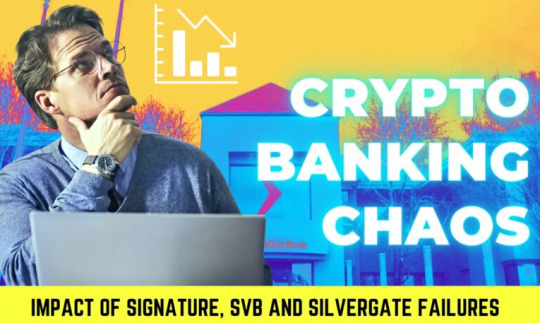#shadows of silvergate
Text

"You're not a bad person, Juggie." — Betty Cooper, SoS
#prep bughead#prep betty cooper#prep jughead jones#werewolf jughead#sos concept art#monster boyfriend#shadows of silvergate#my art#dw lore
82 notes
·
View notes
Text
Andy Flury is founder and CEO of Wyden, a company providing institutional trading technology for digital assets.Over the past nine months, Bitcoin has seen a surge of around 50 percent. Blackrock, the world's largest asset manager, has applied for a BTC ETF. And Germany's largest credit institution, Deutsche Bank, is currently in the approval process for a crypto custody license. Added to this is MiCA and thus increased regulatory security for institutional investors. All this leads to institutional adoption being at a significant threshold – which makes the decision for the right infrastructure all the more important.However, things looked quite different in the crypto market last year. In the crypto winter of 2022, Terra-Luna and Celsius stumbled, Three Arrows Capital was ordered to liquidate, major players such as Gemini, Genesis and Grayscale fought legal battles with the SEC, and in November FTX had to initiate insolvency proceedings and the crypto market valuations took a big hit. In addition, in early 2023, the insolvencies of US banks – Signature, Silvergate, and Silicon Valley Bank – had profound effects on crypto trading, established procedures, and the related venture capital market. This made it clear that the rules of traditional finance, economics and governance did in fact apply to the crypto market. Looking back now reveals many weaknesses in this market that are currently being addressed. A look into the future shows that the institutional adoption of the new asset class is at an important threshold. Even more so as the EU’s MiCA regime will come into force in less than a year, offering European banks a significant market advantage – especially as the United States is falling behind due to its upcoming presidential election.Minimizing Counterparty Risk As A Key Issue For BanksSimilar to traditional assets, cryptocurrency trading includes various functions such as custody or brokerage. These are strictly separated from each other in the TradFi sector as part of stringent risk management policies. However, at FTX & Co, this governance principle was ignored, leading to a cascading negative impact and eventual downfall. Banks should therefore ensure that internal governance guidelines exist and are adhered to when connecting to crypto exchanges and other service providers.As banks chart their digital asset strategy, they confront a market riddled with fragmentation with hundreds of centralized and decentralized crypto exchanges, OTC desks and brokers. To ensure a best execution policy for itself and its clients, which is also required under MiCA, among other things, a bank must connect multiple trading venues to its own platform. These can have large variances in price and liquidity, which can be exploited opportunistically through smart order routing to get the best average price spreading a single order across multiple venues.Diversification is also advisable in the context of risk management. A singular trading venue's collapse could spell a catastrophic asset loss. Connecting several trading counterparties increases the complexity and liquidity costs of a bank, but significantly reduces the risk of default. Rigorous vetting of trading counterparties is necessary as part of the due diligence process in order to clarify liability issues in advance. Here, for example, it should be determined who is liable if a downstream trading platform used by a trading counterparty runs into payment difficulties.After Silvergate And Signature, Importance Of Smart Cash ManagementThe recent downfall of US banks, Signature and Silvergate, cast a long shadow, affecting not just their clientele but the broader crypto trading ecosystem. These banks had facilitated instantaneous USD transfers to crypto exchanges, thereby minimizing assets held at these venues. Current cash management alternatives, however, seem to be in their infancy.While stablecoins grapple with volatility and transactional delays, SEPA offers instant liquidity in euros.
Yet, its transactional caps and limited market reach pose challenges for institutional trading. And FedNow, the instant payment service launched by the Federal Reserve, has yet to establish itself to achieve the desired network effects. Off-exchange settlement solutions via providers such as Copper ClearLoop or Fireblocks are the most likely to provide an effective means of efficient cash management – allowing funds to be transferred instantly to exchange accounts prior to a trade.In addition to a centrally managed liquidity pool, the automation of liquidity management is a useful component of smart cash management. Individual functions such as pre-funding, rebalancing or payment settlement are automated. Another modality is dynamic cash management: in this way, money parked with crypto exchanges can be increased during trading hours and reduced or withdrawn completely outside of trading hours.Trade Lifecycle Orchestration And Seamless IntegrationThe technical implementation of trading cryptocurrencies requires a bank to connect additional systems to their core banking infrastructure. A custodian suitable for institutional-grade trading secures the private keys that enable safekeeping of client assets. Furthermore, a trade order execution system that can access various crypto exchanges is needed.Finally, a solution is needed to orchestrate all functions described above, as well as to integrate other functions such as liquidity or risk management. The Wyden platform is currently the only one to offer such a range of functions. In their digital asset strategy, banks must remain attuned to their unique needs, risk profiles, and customer demographics.Banks As Established And Trusted Access PointsEstablished financial institutions have clear incentives to further their digital asset strategies. From a bank's viewpoint, among the four current business cases—crypto, NFT, DeFi, and tokenization—only crypto has consistently demonstrated clear market demand and assured revenue potential for institutions. From a retail or investor perspective, a regulated bank's digital asset offering presents an elegant solution – bridging the need for security and convenience. A regulated bank as a "trustee" of cryptocurrencies ensures safekeeping of customers wallets. In addition, access to crypto and digital assets is greatly simplified as the bank acts as a one-stop shop for all asset classes – from traditional to digital assets. Wealth advisors can provide comprehensive risk management education and help with portfolio diversification. The expansion of the bank's own offering, e.g. via staking, increases customer convenience, provides the bank with valuable data and further touchpoints, and at the same time makes it a central, trustworthy partner.If banks manage to learn from the mistakes of the past crypto winter, nothing will stand in the way of institutional crypto trading coming of age. The technological prerequisites of a professional and integrated trading ecosystem are there. The task now is to implement them across the board in the banking sector – even more so as MiCA will add increased regulatory certainty for financial institutions. Considering the evolving landscape, it's evident that beyond just infrastructure, regulation is pivotal for an institution's digital asset strategy. This will inevitably lead to diverse regulatory regimes across different regions, significantly influencing their attractiveness. Consequently, for European banks in particular, it's imperative to not only build internal knowledge and infrastructure but also to stay abreast of these regulatory shifts.This is a guest post by Andy Flury. Opinions expressed are entirely their own and do not necessarily reflect those of BTC Inc or Bitcoin Magazine.
Source
0 notes
Photo

New Post has been published on http://cryptonewsuniverse.com/silvergate-capital-silicon-valley-bank-amp-signature-bank-have-all-collapsed-more-to-come/
Silvergate Capital Silicon Valley Bank amp Signature Bank Have All Collapsed More To Come?


Silvergate Capital, Silicon Valley Bank, & Signature Bank Have All Collapsed. More To Come?

The recent scandals of Signature Bank, SVB, and Silvergate Bank have made headlines and left the industry reeling. However, the ramifications of these financial institutions' missteps for the crypto sector are yet to be entirely clear. To understand the impact, one must first look at the fundamental principles of blockchain technology and how it has upended traditional banking models.
The failure of these Banks in the United States means that many are questioning the sustainability of the cryptocurrency sector. The companies in question have all gone bankrupt, but this isn't the first time a major company has failed in the crypto sector. For example, the collapse of Mt. Gox and its affiliates in 2014 has cast a shadow on the industry, but this is not the only failure incident in this sector.
New York state financial regulators closed Signature Bank in what is believed to be the result of the Silicon Valley bank failure, as nervous depositors pulled funds out of Signature Bank. The bank's stock began to fall. The collapse of Silicon Valley Bank is expected to put pressure on several other small and regional banks in the United States.
In less than seven days, the largest bank for tech companies and two banks most accommodating to the cryptocurrency industry collapsed. The sad incidents generated uncertainty in the stablecoin market, despite cryptocurrency values rising Sunday night as the federal government intervened to offer depositors a safety net.
Silvergate Capital announced that it would be closing down and liquidating its bank. Major startup lender, Silicon Valley Bank, failed after its customers withdrew more than $42 billion in response to the bank's disclosure that it needed to borrow $2.25 billion to strengthen its balance sheet. Banking officials seized Signature on Sunday night; it had a significant crypto emphasis but was far bigger than Silvergate.
Approximately half of all venture-backed startups in the United States had cash on hand at Silicon Valley Bank, various firms that deal in digital assets, and venture capital funds that support cryptocurrencies. For bitcoin businesses, the two leading banks were Signature and Silvergate. The federal government stepped in to guarantee every deposit SVB and Signature depositors made. This action increased confidence and caused the price of bitcoins to increase briefly.
Nic Carter of Castle Island Ventures argues that the government is once again pursuing a loose monetary policy rather than one tightening since it is willing to support both banks. Historically, this has benefited speculative asset classes like cryptocurrency. However, the instability once more highlighted the frailty of stablecoins, a part of the bitcoin ecosystem that investors can often rely on to maintain a particular price. Stablecoins are intended to be tied to the value of a physical good, such as a fiat currency like the U.S. dollar or a commodity like gold. Yet, good financial conditions may prevent them from falling below their pegged value.

Image Source: Coindesk
Not Entirely Stablecoin
With TerraUSD's demise in May of last year, many of crypto's issues over the previous year have roots in the stablecoin industry. Meanwhile, during the last several weeks, regulators have focused on stablecoins. After much pressure from New York regulators and the SEC on its issuer, Paxos, Binance's dollar-pegged stablecoin, BUSD, saw significant withdrawals.
USDC lost its peg over the weekend and fell as low as 87 cents after its issuer, Circle, acknowledged having the sum of $3.3 billion banked with SVB. As a result, the sector's trust suffered once more. Circle has established itself as one of the best in the ecosystem of digital assets because of its links to and support from the conventional banking industry. It has long intended to go public and secured $850 million from investors like BlackRock and Fidelity.
Another popular dollar-pegged virtual currency, DAI, partially supported by USDC, dropped as low as 90 cents. For these reasons, USDC to dollars conversions has been temporally halted on Coinbase and Binance. Tether, the biggest stablecoin in the world with a market valuation of more than $72 billion, has seen many conversions from DAI and USDC in the past few days. The issuing company had no exposure to SVB. However, there have been concerns about tether's operations and the state of its reserves.
Circle published a post stating that it would "fill any gap utilizing company resources," this enabled the stablecoin market to recover. Since then, the USDC and DAI have turned back toward the dollar.
Reasons Behind The Ruins of Crypto-Friendly Banks
Silvergate Capital, a holding company for a bank that had made significant bets on serving the burgeoning crypto economy since 2016, announced that it would cease operating as a bank. State authorities ordered the closure of Silicon Valley Bank (SVB), which had long performed a similar function by handling funds for businesses with venture capital funding.
In broad strokes, the same problem classic bank runs brought down both banks. Whether they are crypto exchanges or software firms, their former clients deal with significant commercial difficulties, partly due to the current financial and economic climate. As a result, deposits have decreased, and cash withdrawals have increased at a time when many of the banks' long-dated non-cash holdings have also been negatively impacted by the markets.
Hence, Silvergate and Silicon Valley Bank were forced to sell those underlying assets at significant losses when cash demands reached a certain level. In the fourth quarter of last year, Silicon Valley Bank, which had a bigger total balance sheet, and Silvergate reported losses on the sale of assets of $1 billion and $1.8 billion, respectively. Importantly, a substantial amount of the losses in both situations were attributable to the liquidations of U.S. Treasury bonds.
This serves as a valuable counterpoint to the careless mischaracterization of FTX's collapse as a "bank run" by several prominent media outlets back in November. There are a few similarities between what occurred at FTX and the liquidity difficulties that impacted Silvergate and SVB. These challenges have two upstream causes: the business cycle and the Federal Reserve's tightening interest rates. These elements are connected and fundamentally refer to disturbances brought on by COVID.

Image source: cryptoofficiel.com
The initial pressure that destroyed Silvergate and SVB resulted from Fed rate rises. It was clear that the increasing Treasury rates would discourage new investment in high-risk industries like tech and cryptocurrency. But another, mostly disregarded danger to the health of banks is the rise in interest rates. As the Wall Street Journal notes in uplifting clear language, issuing new Treasury bonds with greater yields has decreased the market value of pre-hike Treasuries with lower yields.
Most banks are legally required to keep significant quantities of Treasury securities as collateral, so they are susceptible to the same risk that affected Silicon Valley Bank and Silvergate. That's one of the reasons why bank stocks, especially those of regional or mid-sized banks, are falling.
Yet, Silvergate and Silicon Valley Bank had unique business cycle problems that might only apply to a select audience. Both catered to markets that witnessed enormous runups in the early phases of the COVID-19 pandemic, namely the crypto and venture-funded tech industries. The COVID lockdowns benefitted both industries, but cryptocurrency specifically profited from the pandemic relief funds distributed to Americans.
So, through 2020 and 2021, both banks had significant inflows. The balance sheet of Silicon Valley Bank quadrupled between December 2019 and March 2021. In 2021, Silvergate's assets also rose significantly. When interest rates on those bonds were still at or near 1%, both banks would have purchased more of them as collateral to support that deposit growth. Because of Fed rate increases, rates on new bonds are now closer to 4%, which reduces demand for older bonds. That's why Silvergate and SVB were forced to sell liquid assets at a loss when clients in booming or turning industries began withdrawing their deposits.
We're still in Covid Economy
If you focus only on one aspect of the situation, you can cherry-pick explanations to blame this disaster on whoever suits your prejudices. But the reality is that everyone is trying to escape the same COVID-caused disaster in the same leaky lifeboat, battling over who gets eaten first.
Some people may criticize the Fed for raising interest rates, especially the crypto traders, yet doing so is required to control inflation.
The inflation, in turn, was brought on by COVID-19-related actual cost increases and a materially increased money supply due to COVID relief and bailout actions. An anti-Fed criticism at this time is, at best, reductive since it will take years to fully assess the total cost and value of such initiatives.
On the other hand, it will be alluring for many in the mainstream to attribute the impending banking crisis to the cryptocurrency industry as a whole. The fact that Silvergate, ‘the crypto bank,’ failed first is the strongest argument in favor of this assertion. You could hear it described as “the first domino to fall" or other such nonsense in the coming weeks, but that isn't how things stand.
Due to its involvement in a sector-wide degenerate long bet on cryptocurrencies that was well in advance of real acceptance and a sustainable source of income, Silvergate was more vulnerable. Yet that wasn't what started its liquidity issue, and its decline won't significantly contribute to any further bank failures in the future.
Instead, all American banks are subject to many of the same structural forces, regardless of whether they are financing server farms or the physical corn and pea version. A deadly virus that has killed more than six million people is the core cause of their severe economic upheaval. If there is one thing to learn right now, adjusting financial levers won't completely eliminate that type of instability in the present chaotic world.


About: Prince Chinwendu. (Nigeria) Rapid and sustainable human growth is my passion, and getting a life-changing opportunity into the hands of people is my calling. Empowering entrepreneurs provides me with enormous gratification. Find me at my Markethive Profile Page | My Twitter Account | and my LinkedIn Profile.
0 notes
Note
For the ‘build a blurb’ prompt….
Prep!Bughead 🙅♀️ and 🔪 (and 🖋!)
It all happened so fast. The mystery, the river, the siren. And now here she was, dodging her boyfriend’s attacks as she tried reaching beyond his clouded mind.
Looking into his eyes, Betty could see he was in too deep. The hypnotism made his once shining crystal orbs into blank blues.
“It’s no use, human. Nothing can break my charm,” The siren’s voice echoed all around the thick mist. “Not until he kills you, anyway.”
Betty winced as the sharp metal grazed her cheek. Even so, she did not let it deter her from her main objective.
“Can he even see what he’s doing?!” She asked.
A sinister giggle replied. “Why, of course! That’s the best part. It’s always fun seeing you heathens be hit with grief by something that you couldn’t help but do. So, yes, while he’s damaging you from the outside, he’s fully aware of his actions, enough that it’s torturing him from the inside.”
“Got it. Thanks!” The blonde sighed and grinned.
She stopped dodging Jughead’s blows and gave in when he tackled her to the ground. ‘Just as long as I’m aware, I can fight it off,’ was what he once told her and Betty let herself give in.
She stared back at his empty eyes as soon as he raised his knife to the side—a signature move he had when his goal was to slice and not stab—and brought it swing down in less than a second.
Betty didn’t flinch. Not even when the cold blade slightly grazed the side of her neck, the same one Jughead had in his trembling clenched fist, before it was suddenly lifted away and thrown head first like a lethal dart into a random direction in the fog.
The siren’s scream could be heard for miles but Betty only focused on the man above her. His eyes were still clouded and he was still like a breathing rock. When it was obvious he wasn’t going to anything anymore, Betty lifted a hand to cup his cheek.
“Jug?” She asked, carefully sitting up with both her hands now supporting his cheeks.
He didn’t answer, though as the Siren’s cries ceased, Jughead’s shoulders went limp and he slowly slumped forward until he had his head buried into the crook of her neck—the same side he almost cut.
“I’m sorry.” He whispered.
“It’s alright,” Betty hugged him. “I’m okay.”
#prep bughead#shadows of silvergate#dunno if it’s close to the prompt but#yeh#prep betty cooper#prep jughead jones#The amount of trust she has in him is#unfathomable
14 notes
·
View notes
Text

The stained glass scene🤌🤌
19 notes
·
View notes
Text

WIP doodle. Betty finally has her final design😭😭
#prep bughead#prep betty cooper#prep jughead jones#shadows of silvergate#I've been having trouble with keeping their designs consistent#but not Betty has her difinitive design#now all I need if for Jughead's to cooperate😅😅
43 notes
·
View notes
Text




Expressions of Betty Cooper👍👍
20 notes
·
View notes
Text

Merry Christmas, y’all☃️☃️
#prep bughead#prep betty cooper#prep jughead jones#shadows of silvergate#pen the shadow boyfriend#my art#werewolf jughead
66 notes
·
View notes
Text

POV: You caught them on a date👀👀
92 notes
·
View notes
Text

In one scarf🥺🥺
88 notes
·
View notes
Text

Happy Halloween🐺🐺!!
#prep bughead#prep jughead jones#prep betty cooper#werewolf jughead#werewolf art#shadows of silvergate#my art#monster boyfriend
53 notes
·
View notes
Text

Stay warm, y'all🧡🧡
34 notes
·
View notes
Text

A little spoiler for you guys directly from the drafts:
At first, Jughead thought Betty had placed something on his lap, never expecting it to be herself until he opened his eyes to search for her.
This would be the third time she caught him off guard.
Her shoulders were stiff and she looked surprisingly bashful with her cheeks glowing bright red and her mouth pursed into a thin line—things that he ended up copying.
"Veronica told me sitting on your partner's lap makes them feel nice," Betty said, plopping her head on his shoulder and causing her boyfriend to short-circuit.
Jughead was at a loss for words. His his throat felt dry and his lungs cried for the air he was holding.
Being too focused on his body's malfunctions, he didn't realise his arms slowly wrapped themselves around her. Somehow she felt smaller like this. And warm. It soothed him in a way that made him feel like he was melting.
And then he felt his head trapped between her hand and her lips.
She kissed him.
"That, too," Betty shared with a crack in her voice before she put her head back on his collar.
(Neither of them know how to act in a romantic relationship so let them have their awkward phase 😂😂 Especially Betty.)
62 notes
·
View notes
Text

Felt bad for leaving this little guy out of yesterday's post (kind of) so he gets his own scarf.
#pen the shadow boyfriend#pendleton#prep jughead jones#shadows of silvergate#prep bughead#monster boyfriend
42 notes
·
View notes
Text

These two would definitely slay at a Halloween party even without Jughead needing a costume🤌🤌
49 notes
·
View notes
Text
Sins of the Father

Betty gets to really look at all the harm her family has brought upon others.
#prep bughead#prep betty cooper#prep jughead jones#prep sabrina spellman#shadows of silvergate#my art
26 notes
·
View notes